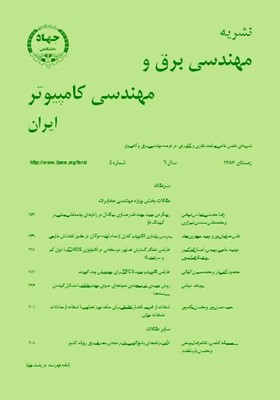يک روش ترکيبي جديد برای تخمين پديدههاي کيفيت توان بهصورت تفکيکشده با استفاده از شبکه عصبی وفقی
محورهای موضوعی : مهندسی برق و کامپیوترحميدرضا محمدی 1 , علی یزدیان ورجانی 2 , حسین مختاری 3
1 - دانشگاه برق و کامپيوتر
2 - دانشگاه تربیت مدرس
3 - دانشگاه صنعتی شریف
کلید واژه: تخمين پديدههای کيفيت توانجبرانسازی انتخابیجبرانساز يکپارچه کيفيت تواننرون خطی وفقی,
چکیده مقاله :
با توجه به گسترش روزافزون پديدههاي کيفيت توان و همچنين گسترش دامنه کاربرد تجهيزات حساس به اين پديدهها، ضرورت جبران پديدههاي کيفيت توان امري اجتنابناپذير است. با استفاده از تجهيزات جبرانسازی سری، موازي و يکپارچه ميتوان بهطور همزمان اغتشاشات ولتاژ، جريان و يا هر دو را جبران نمود. يکي از مهمترين مراحل در جبرانسازی دقيق و بهينه پديدههای کيفيت توان، تخمين سريع و دقيق آنها بهصورت تفکيکشده و مجزا از هم ميباشد. در اين مقاله يک روش ترکيبي جديد، مبتنی بر استفاده از يک تخمينگر يکپارچه وفقی، ارائه شده است که قادر به شناسايي و تخمين سريع و دقيق پديدههاي کيفيت توان بهصورت تفکيکشده و مجزا ميباشد. اين روش در مقايسه با روشهای متداول ضمن کاهش حجم محاسبات از مزايايي همچون محاسبات ساده و سريع برخوردار است. لذا استفاده از اين روش در کاربردهاي زمان واقعی همچون جبرانسازی انتخابی پديدههای کيفيت توان توسط فيلتر اکتيو سری، فيلتر اکتيو موازی و جبرانساز يکپارچه کيفيت توان، بسيار مناسب خواهد بود. با استفاده از نتايج شبيهسازي در شرايط گذرا و ماندگار، کارايي روش ارائهشده نشان داده خواهد شد.
With respect to increment of power quality problems and also increasing application of sensitive devices to such problems, the power quality enhancement becomes a serious concern. The series-shunt and combined compensators can be used for compensation of voltage, current, or both voltage and current. One of the most important stages for precise and optimized compensation of power quality parameters is the fast and accurate estimation of individual parameters. In this paper, a new combined strategy based on a unified adaptive estimator is proposed which is capable of detection and accurate estimation of individual power quality parameters. In comparison to other estimation methods, the proposed method has a simple structure, low computation, high precision and is capable of individual power quality parameters estimation. Therefore, the proposed method can be used for on-line application such as selective compensation in series, shunt active power filters, and unified power quality conditioner. The exclusive properties of the proposed strategy will be shown by simulation results in transient and steady state conditions.
[1]N. G. Hingorani and L. Gyugyi, Understanding FACTS: Concepts and Technology of Flexible AC Transmission Systems, IEEE Press,2001.
[2]A. L. Olimpo and E. Acha, "Modeling and analysis of custom power systems by PSCAD/EMTDC,"IEEE Trans. Power Delivery, vol. 17,no. 1, pp. 266-272, Jan. 2002.
[3]P. Pohjanheimo and E. Lakervi, "Steady state modeling of custom power components in power distribution networks," in Proc. IEEEPower Engineering Society Winter Meeting, vol. 4, pp. 2949-2954,Jan. 2000.
[4]H. Fujita and H. Akagi, "The unified power quality conditioner: the integration of series and shunt active filters," IEEE Trans. on Power Electronics , vol. 13, no. 2, pp. 315-322, Mar. 1998.
[5]E. Oran Brigham,The Fast Fourier Transform and its Application,Prentice Hall, Englewood Cliffs, NJ, 1988.
[6]P. K. Dash and A. M. Sharaf, "A kalman filtering approach for estimation of power system harmonics," inProc. 3rd Int. Conf. on Harmonics in Power Systems,pp. 34-40,Nashville, Indiana,Sep./Oct. 1988.
[7]O. Poisson, P. Rioual, and M. Meunier, "Detection and measurement of power quality disturbances using wavelet transform,"IEEE Trans.on Power Deliv., vol. 15, no. 3, pp. 1039-1044, Jul. 2000.
[8]Y. Liao and J. B. Lee, "A fuzzy expert system for classifying power quality disturbances,"Int. J. of Electrical Power & Energy Systems,vol. 26, no. 3, pp. 199-205,Mar. 2004.
[9]A. K. Ghosh and D. L. Lubkeman, "The classification of power system disturbance waveforms using a neural network approach,"IEEE Trans. on Power Delivery, vol. 10, no. 1, pp. 109-115,Jan. 1995.
[10]A. A. Girgis and F. M. Ham, "A qualitative study of pitfalls in the FFT,"IEEE Trans. on Aerospace and Electronic Systems, vol. 16,no. 4, pp. 434-439, Jul. 1980.
[11]P. K. Dash, D. P. Swain, A. C. Liew, and S. Rahman, "An adaptive linear combiner for on-line tracking of power system harmonics,"IEEE Trans. on Power Syst., vol. 11, no. 4, pp. 1730-1735, Nov.1996.
[12]M. I. Marei, E. F. EL-Saadany, and M .M. A. Salama, "A processing unit for symmetrical components and harmonic estimation based on a new adaptive linear combiner structure,"IEEE Trans. on PD,vol. 19, no. 3, pp. 1245-1252, Jul. 2004.
[13]P. K. Dash, D. P. Swain, A. Routray, and A. C. Liew, "An adaptive neural network approach for the estimation of power system frequency,"J. Electric Power System Research, vol. 41, no. 3,pp. 203-210, Jun. 1997.
[14]M. I. Marei, E. F. EL-Saadany, and M. M. A. Salama, "Envelope tracking techniques for flicker mitigation and voltage regulation,"IEEE Trans on Power Deliv., vol. 19, no. 4, pp. 1854-1861, 2004.
[15]Q. Ai, Y. Zhou, and W. Xu, "Adaline and its application in power quality disturbances detection and frequency tracking," Electric Power Systems Research , vol. 77, no. 5, pp. 462-469, Apr. 2007.
[16]H. R. Mohammadi, A. Yazdian Varjani, H. Mokhtari, and M.Nayeripour, "Fast and accurate frequency and harmonic estimation method for on-line application in power system," in Proc.Int. Conf.on Power Engineering, Energy, and Electrical Drives,POWERENG2007, pp. 690-695, Setubal, Portugal, 12-14 Apr. 2007.
[17]B. Widrow and M. A. Lehr, "30 years of adaptive neural networks:perceptron, madaline, and backpropagation," in Proc. of the IEEE,vol. 78, no. 9, pp. 1415-1442, Sep. 1990.


